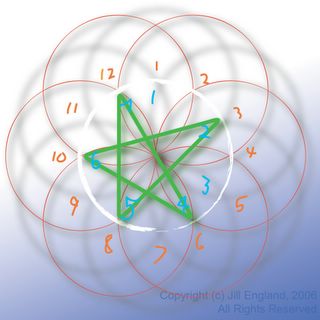You can create one of these diagrams yourself with a compass or circle template. I've used these diagrams to demonstrate the relationships between waves (circles), and the numbers twelve, seven, five, and three. Sixty and three hundred sixty are actually multiples of twelve so they are also natural circle division units.


This diagram represents an Octave. The distance of once around the circle is one octave or twice the frequency of the base note. In reality this is a logrithmic spiral. The spiral is flattened in this representation to form just a circle, the log of the spiral which greatly simplifies the diagram.
A circle or wave can naturally be divided into six separate parts defined by the radius of the initial wave/circle. Also there is a matching counter wave(i.e. sine to cosine )that would cancel out the initial wave. This can also be divided into six segments. The result is a natural circle or wave division into twelve parts. Sixty and three sixty are multiples of 12 so a degree, or 360'th of a circle is a natural circle division.
I've tried to be simple but, it's probably about as clear as mud for someone who has never seen this before. So here is a simple exercise to get you started;
1. Materials, you need a compass or circle template, paper, and pens or pencils of three colors. (You can draw it all in one color if you like but, the diagram will be clearer if you use three.)
2. Draw a circle in the middle of the paper. You will divide this circle with additional circles of the same size.
3. Draw two lines through the circle, one vertical and one horizontal. A plus "+" where the center of the plus is the center of the circle.
4. Change colors; Where the vertical line intersects the top of the circle make that the center of and draw another circle.
5. Draw two more circles centered on the intersection of the circles.
6. Continue this until you have drawn six circles.
7. Change colors and draw six more circles starting from the horizontal line intersection instead of the vertical;
8. You will now have twelve equally spaced points around the circle.
At this point if you know a little music theory you can see how you could choose points to represent a standard scale. This still doesn't explain five note and seven note groupings. I'll get into that a bit more in my next post. Bring your guitar, pianos kind of obscure a scales relationship to the notes, though you can use any musical instrument available to play and compose with this new musical tool.
Music without sound is almost useless.
No comments:
Post a Comment